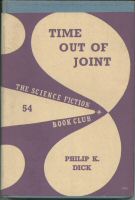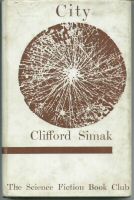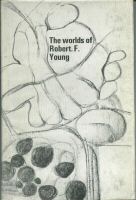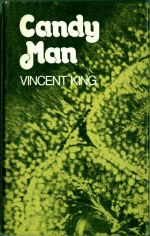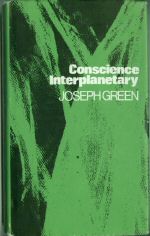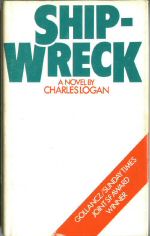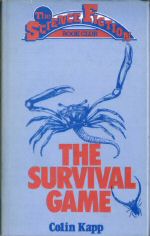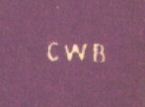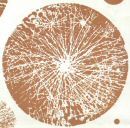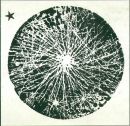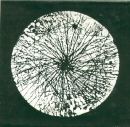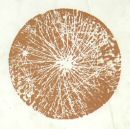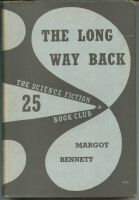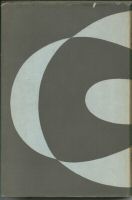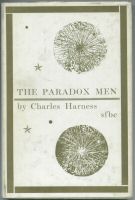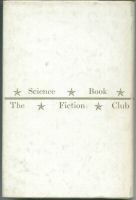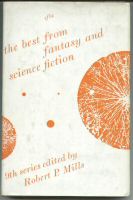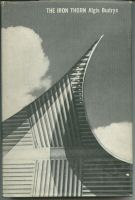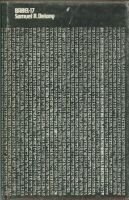The Covers - an initial sample and outline guide
Examples of the three of the four dustjacket styles of the brightest and best time of SFBC - No 54, TIME OUT OF JOINT, is the last of the 'swirlys', number 55, CITY, first of the 'tree-rings', JOYOUS INVASIONS (110) the last of the 'tree-rings', and numbers 116 and 118 (WORLDS OF ROBERT F YOUNG and ALL FLESH IS GRASS - below) are early examples of the 'black&white' though obviously the Young is more to the white side of that.
See below for further examples and for more but still sketchy details of the artists involved.
(I have no idea why the dj of TIME OUT OF JOINT was trimmed top and bottom - ask previous owner Peter Womersley, who got it hot off the presses in October 1961.)
A startling collection of later SFBC issues, all after the departure of credited - and creditable - artist TERRY JAMES who did all the covers from issue 117 (THE EIGHTH SEAL) to issue 170 (DEATH OF A COSMONAUT).
It will be no surprise that these uninspired - some actually quite horrible - designs have no credits in the books. Work done for hire indeed, no doubt at the lowest price negotiable.
CANDY MAN is issued October 1972, CONSCIENCE INTERPLANETARY is from March 1973, SHIPWRECK from August 1976, SURVIVAL GAME May 1978, and FROSTWORLD AND DREAMFIRE from 1979.
One of these books is actually worth reading. And is rather better than you might imagine. Can you guess which one? (Don't read them all to find out - life is too short....)
The Artists -
first if not
foremost
C W Bacon
Up to mere hours ago as I write (5.22pm, Saturday 25th March 2006, if you really want to know) the identity of the artists or designers responsible for the SFBC bookjackets was pretty much a mystery. Around here anyway. Using a bit of common sense (actually examining the books looking for clues) and tapping the Jiant Branes of the Wegenheim mailing list has changed all that though.
Now we know that the character responsible for the Swirly djs that appeared on issues 1-54 was one C W Bacon, an artist of some considerable style and distinction who did a number of bookjackets between the 1930s and 1970s. This realisation is down to good old Bill Burns, who posted thus -
"I found a number of book dealer catalogue listings with
CWB artwork, books published from 1941 to 1964, two of them Australian
printings. And further down in the search, this useful page: http://www.classiccrimefiction.com/bacon.htm
CW Bacon, aka CWB!
Here's one of his originals, with a
sticker from his agent: http://www.massmedia.com/~mikeb/booktour/c_w_bacon.htm
And
Google Book Search tantalizing gives only a fragment from his entry
in Bernard Dolman's Who's Who In Art: Signs work: "CWB"
or "CW Bacon." Address: 6 The Lawn, St Leonards-on-Sea,
Sussex."
The Arrival of John Griffiths, plus Blob
From SCIENCE FICTION NEWS Number 55, November 1961
About our New Jacket Design
SF ART
For many years I have thought that someone ought to do something about the one thing which puts more people off science fiction than any other single factor - viz., the wretchedly mistaken idea of illustrating it, in colour, on the covers of the magazines (and, all too often, in black and white inside them).
As a painter myself I am not averse to having a bash at most of the subjects that interest me, but I cannot seriously attempt to depict Martian cities, Venusian carrot men, Sirian octopoedal humanoids or spaceships bursting through a cloud of inter- stellar dust. Nor, as a purchaser of innumerable mags and paperbacks, do I want the vivid imaginings of Simak, Pohl and Van Vogt brought down to the level of pulp comics by artists who cannot match the authors in fertility of ideas and who, in any case, are usually hampered by publishers’ demand that their product stand out on the bookstalls (where no doubt it keeps company with titles such as I was a Sex Mad Teenager in Soho, Sadism at Scotland Yard or Vice Gang on the Prowl). Hence almost every book jacket, if it does not show a flaming spaceship plunging into the sun, bears a half naked and bosomy alien in a translucent gown of shimmering and diaphanous alien fibre in the clutches of a hackneyed, bug-eyed monster from Pluto.
No, if our sf is going to be visualized, it must be by someone like John Griffiths, the designer of our new standard wrapper - in other words the treatment must be abstract and suggestive, not literal and suggestive.
Anyway we hope you like the new design, whether or not you agree with our general strictures against sf illustration. We think it makes an exciting change and fits the mood of the times and the mood of the subject.
Oliver Caldecott
- and the reaction -
From SCIENCE FICTION NEWS Number 58, February 1962
NEW JACKET
‘I amvery pleased to hear that SFBC is now issuing books every month. Also I hope they will show a different cover every month, as in City, the latest choice.’ C. W. Sussex.
‘I have just received the November issue of the SFBC and I would like to compliment you on the new design for the jackets. I like especially the quality of the paper used. . . . I am very pleased that I will now be receiving a book a month, and I shall look forward to the next issue.’ J. P. Surrey.
‘Congratulations on the new covers. As a new member of SFBC I must admit I was horrified when I removed the paper wrapper on the other three choices received. The new wrapper and cover layout is excellent.’ J. 4. London
‘I like very much your cover, and would suggest that you have a different one each month, perhaps asking for designs from members of the SFBC themselves.’ P K. London.
‘Many congratulations on the new style cover - I think it is a great improvement on the former. I have always destroyed the dust jacket in the past - I shall do so no longer. I also welcome the plan to issue a monthly choice.’ S. M. Surrey.
‘I have hitherto been a silent, but nevertheless very satisfied customer! However I should like to express a special word of appreciation of the new style of jacket and binding. They are very good and a considerable improvement. Thank you.’ J. C. London.
‘The new jacket is drab. It spoils the line of colourful SF jackets on my shelf. The design looks like a poor photographic reproduction of fibres under a microscope and is as symbolic of SF as a stick of rhubarb.’ R.W.D.
John Griffiths and The Peripatetic Blob
The 'tree ring' era is still something of a mystery - in most or indeed all of the issues from 55 - 110 there is a credit for "Wrapper design by John Griffiths" but beyond that we're presently baffled. It's not even clear as to whether Griffiths actually did each dj personally, or simply had come up with the general idea and the ever-present tree-ring (or cloud-chamber, or indeed weird alien bacteria...) motif.
However, each cover of this period was actually different, so a little more effort was being put in than had been made before, whatever the charms of CWB's cheerful swirls.
So what is this thing anyway? Around here it was first known as the 'tree-ring', but more recently as just the Blob. It first appeared on SFBC 55 of November 1961, credited to John Griffiths as above, but with no indication of what it might represent. (OK, we are lacking in sight of the relevant issues of SFN, which probably make it all clear...).
The Blob first appears in SFBC ads in the BRE ANALOG for June 1962, which is peculiar as it had been used on the actual books for several months by then; previous ads in late 1961- early 1962 hadn't featured the Blob even though almost all the books noted have that format cover.
Indeed it seems that the first time the Blob is actually referred to is in the ad in ANALOG November 1962 which is more or less identical to that for January 1963 shown elsewhere on this website. However the text has it - "This is not an alien life form... it's a peripatetic blob of terrestrial origin which has recently found its way into the homes of thousands of of members of the Science Fiction Book Club via the striking and original dust jackets of the Club's superb 5/9 monthly choices."
Hmm. "blob", eh. Well, personally I'm still thinking
'tree-rings' but then that's my problem. Others have it differently
- Catherine Pickersgill opines
"Anyone of you having
problems working out what the swirly and the tree-ring patterns
are may be helped by the knowledge that, in my opinion, the swirly
is an antenna radiating, and the tree-rings are a cloud-chamber."
Rog Peyton has other ideas - "And the 'tree rings' design has been niggling me for days. Obviously they weren't tree rings but I 'knew' they were something 'scientific' and basic like a magnified snowflake. And this morning I woke up and the answer came straight to me. That 'tree ring' is a photograph of a retina, surely. A very science fictional device - remember all those stories where retina locks were used? Even more individual than fingerprints. It's what we need to read, see the universe and the eye is supposed to be the gate to the inner soul...
I noticed when I had all these books that it is exactly the same design - colour changed, rotated, reversed, resized, negative. The retina pattern of the 'artist', maybe?"
Jim Linwood sorta sits on the fence - "The *lines* in the retina are blood vessels and not straight radiating lines. I think the design is purely abstract.....except it does look like the patterns produced by the Wilson Cloud Chamber which makes radiation visible."
Only original designer John Griffiths can really tell us what the Blob really is, I suspect, and the chances of getting into contact with him seem pretty much zero. However he does deserve much praise for coming up with something that was so infinitely adaptable and yet distinctive and hugely science-fictionally evocative.
Actually the most intriguing line in the SFBC ad quoted above is that bit about "thousands of members" - does anyone have even a good guess about how many SFBC members there may have been at any given period? And how many copies of the books were printed? We know that towards the ignominious end there were so few members that regular publishers editions were sent out, but what about the Golden Age?
Do you know - tell us, do!
An intermediate phase -
Tim
Newling
As you will see from the back-cover to the left Tim Newling took over as resident artist from issue number 111 -TELEPATHIST. This proves that 110 (JOYOUS INVASIONS) really was the last tree-ring.
However, nothing lasts for ever and apparently Mr Newling's time was destined to be short - by number 117 he was replaced by Terry James, who as far as I can tell did all the subsequent covers up to the end of the Golden Age with number 170.
I can't say I'm surprised; the Newling covers were insipid at best, and while the James covers with their predominant black were overall a little tedious and dull they do have a sort of gloomy charm by comparison with the vapid greys of the brief Newling era.
Mind you it probably didn't help that Newling, or perhaps someone he should have been overseeing more tightly, made a really huge error on both the front cover and spine of the dustjacket illustrated. Can you see what it is yet?
The spines - variant forms from number 1, EARTH ABIDES, to number
140, BABEL-17.
There was no apparent consistency about
the colour of the cloth.
Front and back of two typical examples of their period - and two of my favorite books also. I doubt I would ever have read THE LONG WAY BACK without getting it as part of my SFBC collection, and as it is I wholly recommend this somewhat dated but still involving and surprising novel to everyone. THE PARADOX MEN is of course a wonderful thing.
It's worth noting too that all the 'swirly' covers used identical patterns in various colours and shades, rather the way that aircraft camouflage is often done according to set rules rather than daubed on at whim. There didn't seem any particular pattern to the choice of colours, though. The overall effect was charming and very 1950s.
Three fairly typical covers - on one really rather good novel and one outstanding anthology. Which is the odd one out?
